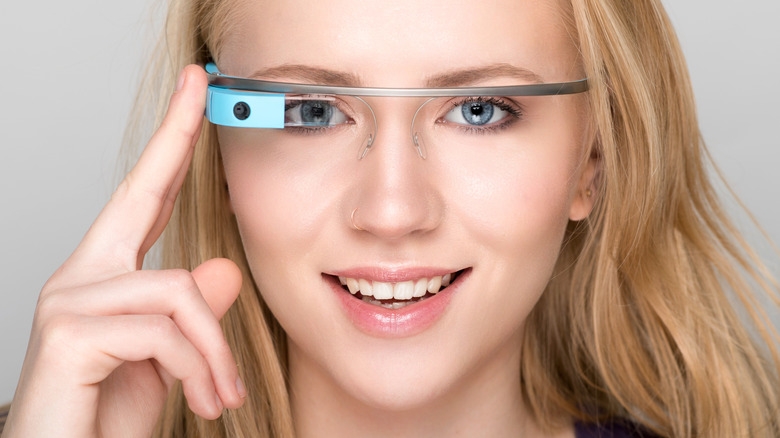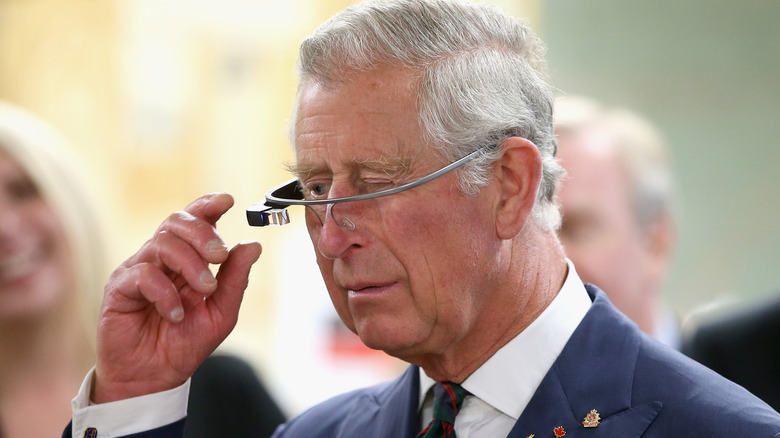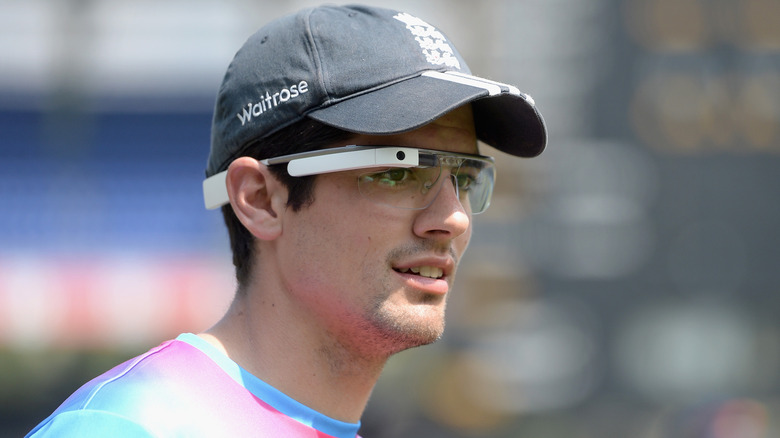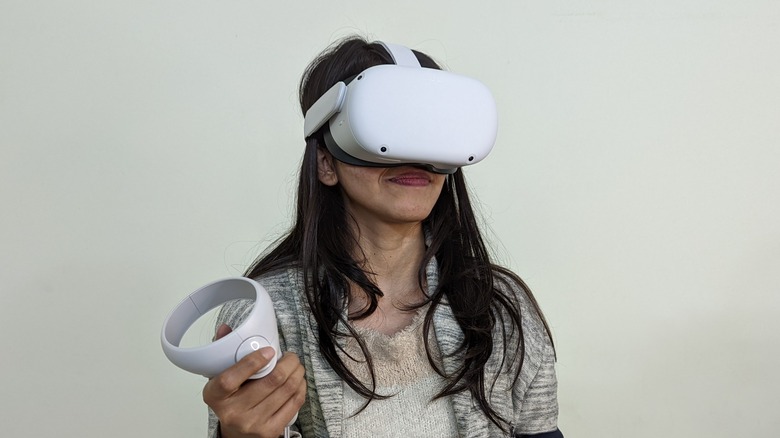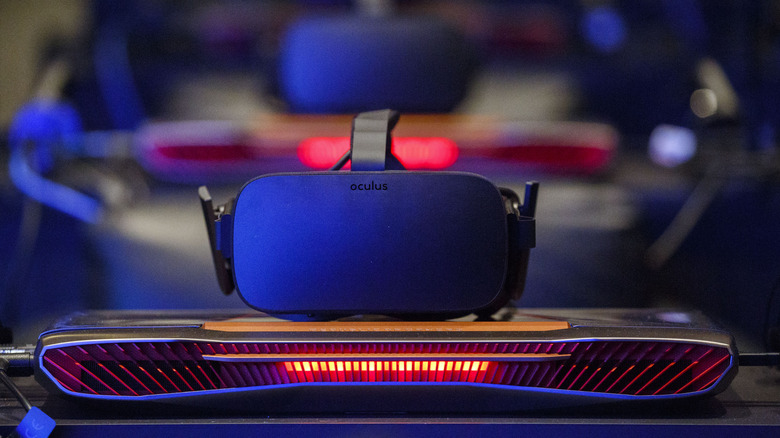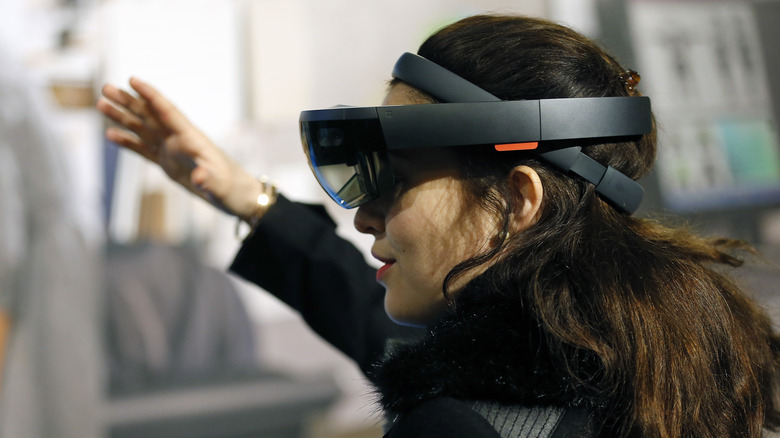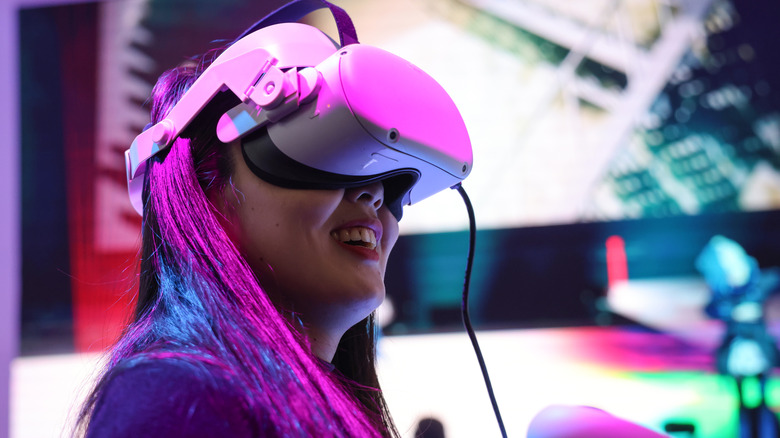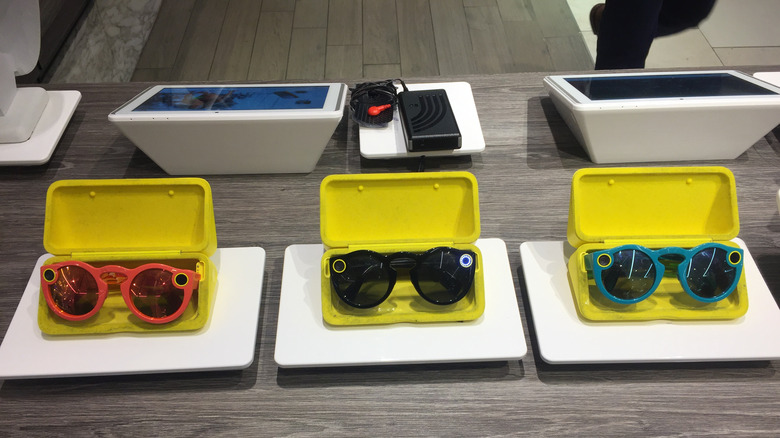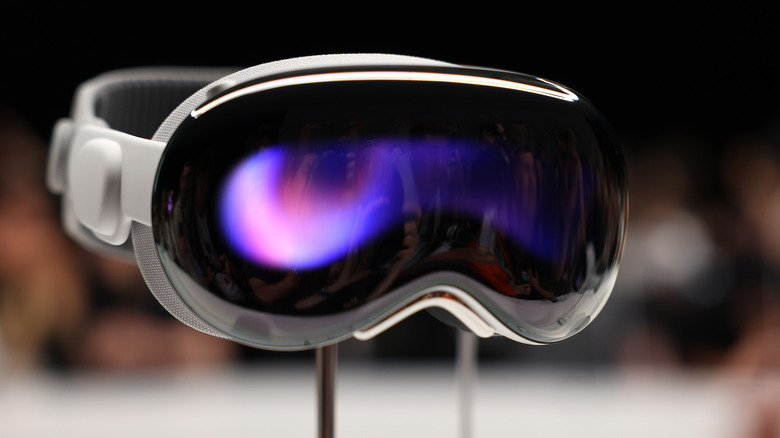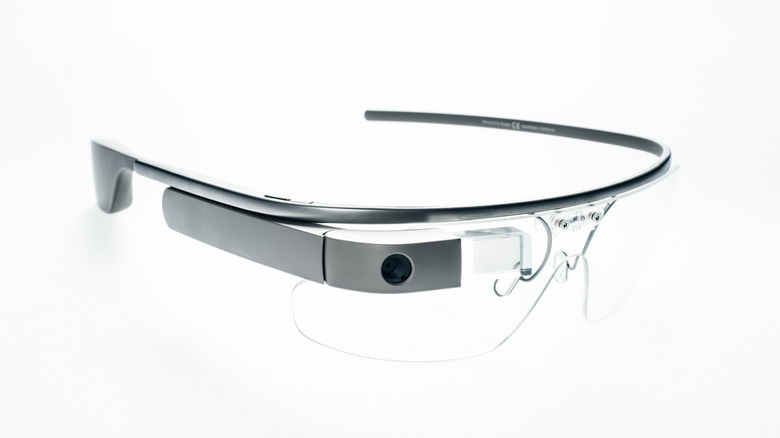How Google Beat Apple To AR And Still Failed
In 2013, a full decade before Apple announced the Apple Vision Pro, Google released its own augmented reality headset. It was called Google Glass, and when it was unveiled it seemed like the future had finally arrived. Inside a device the size of a pair of glasses, Google had managed to fit an entire mobile computer that overlayed information onto the world around you via a small screen in the corner of a user's vision.
Today, Google Glass is yet another in a long line of Google products to be relegated to the wastebin of history. A consumer version of the headset was never launched. Its product page is defunct, and support for Glass was officially discontinued in March 2023. Still, even now, it's clear that Google succeeded at making AR a reality in a way that no one has ever come close to matching. So, how and why did the product fail?
First, it's important to delineate between types of headsets. There are three main categories: virtual reality (VR), which fully immerses users in a digital environment, augmented reality (AR), in which virtual elements are overlayed onto the real world, and extended reality (XR), which combines elements of both and can be used as an umbrella term for all kinds of experiences.
Over the years since Glass first launched, we've seen plenty of other AR, VR, and XR devices hit the market, many of which have sold fairly well. With Apple now entering the field with its Vision Pro headset, we may finally be entering the era of augmented reality that Google failed to usher in ten years ago.
Google Glass put cameras in public before people were ready
When Apple announced the Vision Pro, it advertised the headset's video recording capabilities. However, Apple's presentation focused on a dad recording his kid's birthday, an intimate family moment. What the company made sure not to show is somebody recording strangers on the street, and that's because they remember how people reacted to Google Glass.
Plenty of tech enthusiasts got their hands on an Explorer Edition of Glass in 2013 and headed out to test the gadget. Filming things in public is considered normal in 2023, but in 2013, smartphones were not quite as ubiquitous nor as camera-capable as they are today. People who spotted Glass users in the wild didn't see a person living in the future — they just saw someone pointing a camera at them, and some of them freaked out. CBS reported that one tech writer testing the glasses in San Francisco was confronted by two women at a bar before a man ripped the glasses from her face, while a diner in Seattle banned wearable devices altogether.
It was a reaction we predicted, but still a genuine tragedy. Google Glass had barely taken its first steps before its revolutionary potential was smothered by an uneasy public. It wasn't long before it joined the long list of Google products consigned to the grave.
Functionality wasn't defined for Google Glass
At launch, Google Glass could do about seven things in total. Google's plan was to put the Explorer Edition in the hands of developers who could help to shape its direction. However, in part because no one knew what to develop for it, or possibly because major developers didn't want to spend time on a product that wasn't ready for consumers, the project stagnated.
Google could never decide what it wanted Glass to be or even where it might be worn. It demoed the product during the launch event by having skydivers wear the headset during a jump, suggesting that the device was meant for hands-free adventure and sporting. In other promotional materials, Google showed people using Glass at work, in their homes, and more. Simultaneously, the headset started showing up on fashion runways and soccer pitches. That lack of directive vision was confusing. It rendered Glass a mere curiosity — not something people could actually envision as a part of daily life.
Compare that to the way Apple recently launched the Vision Pro by positioning it as a media consumption platform, a mostly homebound device that you can also toss into your bag for a long flight. Apple is already partnering with major brands like Disney to ensure that there are use cases for the Vision Pro at launch.
The rise of VR
As Google Glass failed to develop, another wearable technology was seeing a renaissance. VR headsets were starting to go mainstream, with companies like Oculus taking off. Those headsets were far less portable, and they had no AR capabilities. They weren't even broadly popular, instead positioned as a luxury for people with expensive gaming rigs and even more money to blow on an expensive headset.
However, what they did have was specific use cases, especially in gaming. Eventually, as these VR headsets matured, they gave way to devices that could operate without a connected PC or gaming console, with cameras mounted around to track their position. Among them were brands like Meta, Microsoft, and Sony.
Naturally, these headsets eventually evolved beyond pure gaming to find applications for fitness, content consumption, and 3D art. Together, they laid the groundwork for today's XR landscape and precipitated the Apple Vision Pro. As they have with many product categories, Apple played the long game, waiting until the market had developed consumer-ready technologies before offering up a competing product.
Google Glass was overshadowed by the Oculus Rift
While the mid-2010s were filled with companies like Razer and HTC releasing their own tethered headsets, the Oculus Rift was a defining moment in the race for VR. By the time of its launch in 2016, it was becoming clear that Google Glass and other standalone AR/XR headsets weren't ready for primetime. On the other hand, technology was finally ready to deliver the VR experience science fiction had long promised us.
In part, the hype was driven by Facebook's 2014 purchase of Oculus, especially since the social media giant had not yet eroded its reputation to the point of needing a name change. It was still viewed as a company that had changed the world once and might yet do so again. Oculus was the beginning of a new age of VR, and the company now known as Meta would continue to iterate on it.
That first Rift had its problems, but alongside other headsets like the HTC Vive, it demonstrated the potential for gaming-focused VR devices and began a VR arms race that continues to this day with the Apple Vision Pro.
Microsoft's HoloLens offered improved enterprise functionality
With the AR/VR race in full throttle, Microsoft joined the fray by releasing the HoloLens in 2016 and following up a few years later with the HoloLens 2.
The device was intended for full augmented and extended reality — where digital objects are overlayed on physical environments — and used some of the same technology the company had developed with its Xbox Kinect gaming platform. While it was a bit bulky, it was far more capable than Glass and Microsoft had a clear vision for it. Understanding that the device was not yet ready for mass adoption, the Seattle tech giant drew on its long and lucrative history with enterprise-facing products to position the HoloLens as a tool for industrial work.
While a consumer version of the HoloLens does exist and can be had for $3,500, the same price as an Apple Vision Pro, Microsoft advertises it as a tool for specialized workplaces such as manufacturing, engineering, construction, and healthcare sites. Microsoft has sold the devices to companies, including Lockheed Martin and Mercedes-Benz, as noted on the HoloLens product page. However, when it comes to the consumer market, no one has made the same inroads as Meta.
The Meta Quest offered a full featured VR experience
When Meta acquired Oculus, its headsets still required a powerful gaming PC to work at their best. Meta aimed to change that by releasing the standalone Oculus Quest in 2018. Unlike its more expensive sibling, the Oculus Rift, the Quest ran on a VR-focused mobile chipset from Qualcomm. While it wasn't the first standalone headset from Meta — that prize goes to the earlier Oculus Go — it was the first to receive widespread praise. For the time, its capabilities were astonishing, especially considering that it was an all-in-one device.
The company followed up on that success with the Oculus Quest 2, which would later be renamed the Meta Quest 2 when Facebook was renamed to Meta and did away with the Oculus brand. Though it was released over three years ago, the Quest 2 has only gotten better. When it shipped, it was a VR-only device, but thanks to software updates it now has XR functionalities trickled down from the more premium Quest Pro released in 2022.
However, Meta has seemed to stumble since its rebranding. At this point, it seems to have lost the trust of many and can no longer claim to be a driving force in the AR/VR/XR space. Though the Quest 3 arrives in Fall 2023, Apple has a real chance to become a dominant player in this marketplace.
Other competitors offer reduced functionality at far lower prices
In the years since Google Glass, the concept of an eyeglasses-sized digital headset has not been abandoned. Other companies have stepped in to offer their own visions, though their functionalities are much more limited than that of Glass or true VR.
First, there are glasses that double as cameras, a concept as old as spy thrillers. Snap offers the Snap Spectacles and Meta serves up the Ray-Ban Stories, a collaboration with the famed sunglasses brand that can take calls, play music, and capture video and photos. Both work on the same concept — if you see something you'd like to post to your Snapchat or Facebook account, just activate the glasses instead of digging for your phone. Neither of these products has caught on, maybe because Snap sold theirs in strange vending machines, and neither is a true XR device since they don't project anything into your field of vision.
Next up, we have the Amazon Echo Frames, a pair of sunglasses with Alexa built in. There are no cameras, only the ability to access your smart assistant and get notifications. Finally, there are the glasses that attempt to do the impossible and put a fully immersive digital world in a Clark Kent-sized pair of frames. The most buzzed-about devices come from an up-and-coming company called Nreal, with products like the Nreal Air. The trick here is that the glasses don't try to pack in a whole computer — they're just an external display that can be connected to your smartphone.
Can Apple do what Google couldn't?
Apple seems poised to finally make XR and AR mainstream with the Vision Pro. While it's not the slim pair of glasses that made Google Glass seem so futuristic — The Vision Pro is about the size of a pair of ski goggles — it's a far more capable device, and it's rocking the most cutting-edge hardware Cupertino could cook up. VR display specs don't translate well to 2D, but it delivers the equivalent of multiple 4K TVs in each eye. It has a bevy of advanced sensors, including what is by all accounts the best eye tracking on any XR headset. As if that weren't enough, the thing is packing an honest-to-goodness desktop-grade SoC, Apple's battle-tested M2 chip.
So why might the Vision Pro succeed where Google Glass failed? Well, in addition to lacking a clear vision, Google has a history of abandoning products at the slightest hint of failure, while Apple tends to press forward. Neither the first iPhone nor the first iPod were best sellers, but they became massive moneymakers and iconic cultural symbols through generational refinements.
Meanwhile, the competition is anemic. Apple's largest competitor in the AR/VR/XR space, Meta, has struggled to win over investors and consumers alike with its vision for the future, the so-called Metaverse, leaving a lane wide open down the center court. All Apple needs to do now is dunk the ball.
Now is the time to revive Google Glass
Google Glass failed by being too ahead of its time. Not only was the headset off-putting in an era before recording things in public was commonplace, but it was also chasing a dream the technology couldn't yet support.
Today, with the public now more accustomed to technology in our everyday lives and with mobile chipsets more powerful than ever, Glass could be a viable product. Instead of a heads-up display in the corner of a user's field of view, Google might now be able to make a pair of glasses with actual AR functionality. Perhaps they wouldn't be as feature-rich as the Apple Vision Pro, but they'd be something you'd actually wear in public. As impressive as the Vision Pro looks, no one is wearing it out in public unless they lose a bet — it's just too weird looking with its larger form factor and creepy eye animations.
Not only is the technology ready and the time right, but Google Glass is a fundamentally different product than the Meta Quest or Apple Vision Pro. While Apple's VR headset seems purpose-built for media consumption at home, on planes, or in hotel rooms, Google could pursue its initial vision for Glass as a device to be used outdoors. It could replace products like the GoPro for extreme sports enthusiasts, give turn-by-turn directions while walking or cycling, and serve the same purpose as smartwatches for fitness tracking, notification management, and hands-free calling.
There are rumblings that Google may try its hand at AR glasses again and has been investing heavily in the tech behind-the-scenes. If Google has the gumption to revive Google Glass, there's no better time for a triumphant comeback.
